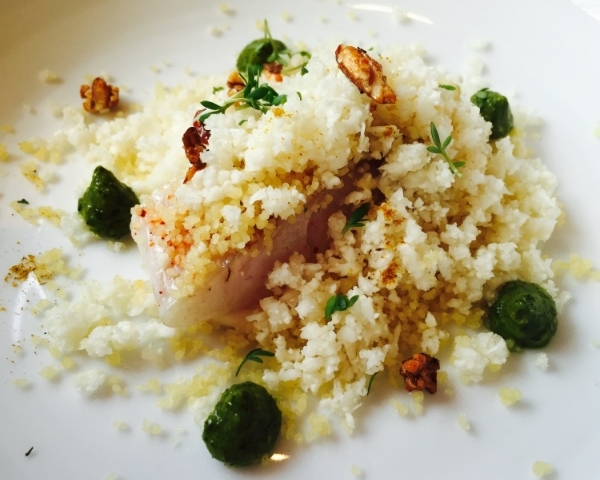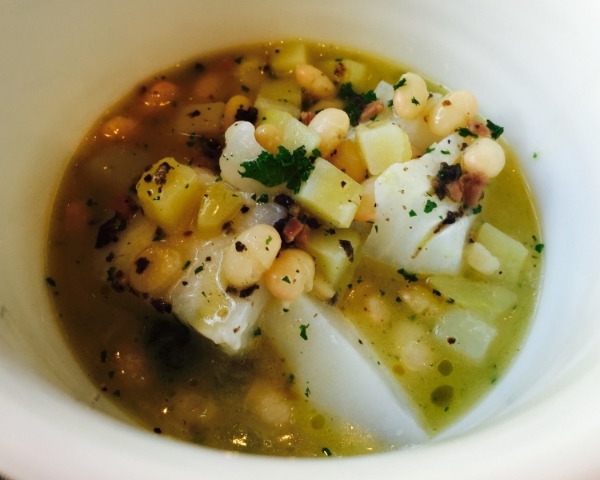Miso-laquered lieu jaune (pollack)
Alexandre Bourdas is a fine painter. And an extraordinary chef. Within his modern and demure, nine-table restaurant just steps from the harbor in Normandy’s historic Honfleur, he paints joyous, colorful works on white porcelain plates, brushing tender lieu jaune with a pungent dose of Japanese miso, and conducts in the background a nearly all-white culinary symphony, tossing in grated cauliflower and semolina, potatoes and white coco beans, going a bit overboard with the whipped cream come dessert time.
I have wanted to sit at his table since he opened to fanfare in 2006, quickly garnering two Michelin stars. And it was a deep desire to sample his signature poached monkfish paired with lime and lovage, coconut, and expressive kaffir lime oil, that transported me there at last.
A disciple of the Auvergnat star-chef Michel Bras, a lover of all things Japanese, and a Normandy native, BB weaves all these influences into his very personal, expressive cuisine. In his hands, a simple rectangle of fish -- barely more than a bite full -- becomes a culinary jewel. Monkfish can so easily turn rubbery and banal if not precisely cooked, yet his barely poached, alabaster lotte brought to mind clouds and angels, offering serious gastronomic pleasure. Even potentially explosive flavors -- a generous shower of lime zest, a frothy broth prepared with freshly grated coconut, the oil extracted from the Asian citrus combava (kaffir lime) -- maintain a subtlety that make you believe you’ve been sampling that brilliant combination of flavors all of your life.
I love him for explaining on his menu each simple technique that is used to cook an ingredient: poached, seared, steamed, boiled, grilled, caramelized. The miso-lacquered pollack (lieu jaune) a fish I usually find deeply uninteresting, here was seared over very high heat, but remained light, delicate, full of personality and freshness. Paired with baby leeks and (a favorite flavor here) tiny black and white rolls of paper-thin daikon (white radish) and nori (dried seaweed paper.) His steamed sea bream (dorade) is smothered in an all-white mix of grated raw cauliflower, grains of semolina, and a crunch of powdered caramelized almonds, all tossed in a gentle vinaigrette. Codfish (cabillaud) is treated with equal respect, parting into flat and tender flakes, set in a broth of white beans and cubed potatoes, minced parsley, and a faint shower of minced fresh black truffles.
After all this fanfare, the rectangle of grilled beef fell flat, out of place, seeming to squash all the previous pleasure. Desserts, like everything that comes from his kitchen, shone with forethought, precision, and expertise, but like the beef, they stood in the way of the memories I was already gathering from the spectacular parade of fish. There’s brioche topped with a pineapple flan (with flavors reminiscent of the pineapple upside-down cake of my childhood), a seriously beautiful mandarin sorbet enveloped in a cloud of crème Chantilly, and an underwhelming wimpy chocolate cake.
La Mandarin
The wine list is extensive, with treasures from throughout the vineyards of France. We opted for a favorite white, the 2013 100% Clairette Châteauneuf-du-Pape Saint Prefert from the hands of winemaker Isabel Ferrando, who has created a white that was young, fresh, direct, and vibrant, and a perfect match for Bourdas’s fish presentations.
Service here is not on par with what’s on the plate: There’s a military stiffness, a lack of enthusiasm, rote deliveries of each dish, that don’t mesh with the professionalism of the kitchen. It took us three hours to make it through the 115€ eight-course menu but that’s just a comment, not a criticism. And my advice is to delete the pascade, an Auvergnat specialty from his mother’s native region, a sort of flat popover that on it’s own might be ok. As served to us, doused with a strange mixture of sugar, chives, and truffle oil, it was, to my mind, a huge mistake.
The restaurant’s name, by the way, has two meanings. In Japanese, sakena it is the word for fish. His personal translation is SAveurs, QUalité, NAture.
Sa Qua Na | 22 Place Hamelin | 14600 Honfleur | Tel + 33 2 31 89 40 80 | Open Thursday through Sunday. Closed Monday through Wednesday | www.alexandre-bourdas.com | saquana@alexandre-bourdas.com | Lunch and dinner: 25€ children’s menu; 75€ 5-course menu; 115€ 8-course menu.



